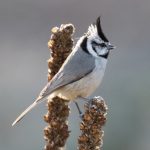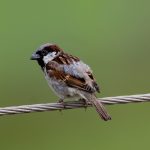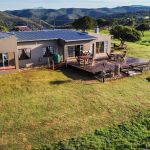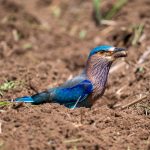There are few families of birds as bewitching as the birds-of-paradise. They are feathered jewels with extraordinary breeding dances almost unrivalled in the bird world. They have been a crucial part of the culture of the islands and forests where they are found for the last 50,000 years, and were amongst the first animals of the East to make it back to Europe with the earliest Portugese and Spanish explorations. Adding to their mystique is the remoteness of their home, the undeveloped and rarely visited islands of New Guinea and eastern Indonesia. To birdwatchers they are a difficult pilgrimage that few don’t want to attempt at some point, but few manage.
There are, however, two species that are more accesible than the rest of the family. Four members of the family are found in Australia, and while two of these are in the no less inaccessible cape York region, two species of riflebird range as far south on the coast of Australia as just north of Sydney. It was one of these species, the Victoria’s Riflebird, that I was lucky enough to see this year in the Atherton Tablelands near Cairns. I saw two, fairly briefly, crossing the road and foraging in the midstory Mt Hypipamee National Park, and quite frankly I was well pleased enough with those fairly brief if still decent views. Both those birds were females, which are brown on top with buff and pale undersides, but they are still elegant birds and bigger than I imagined. I’ve written before about how satisfying I find locating new families, and this was a pretty sweet new family to get.
Things got better a few days later when I arrived at Cassowary House, the site of my encounter with a rather aggressive cassowary. My first encounter there was something of a surprise. I had just managed to park my car after getting it trapped in a tight corner, and was hot and somewhat flustered. I was barely out the door when a few feet above me a shining blue male landed, regarded me for a moment and then flew off.
I never got a shot of a male Victoria’s Riflebird (Ptilotis victoriae), so here is one by David Cook (CC).
Like many of the birds-of-paradise the male riflebirds combine beautiful plumage and elaborate displays in order to impress females (not all, however, the manucodes don’t, and also correspondingly lack the sexual dimorphism of the rest of the family). The females, having selected a mate, will raise the chicks on their own.
httpv://www.youtube.com/watch?v=2VGongXYDGo
A video of something I wasn’t lucky enough to see.
A few minutes later I was sitting on the porch of the main Cassowary House, drinking tea and watching Black Butcherbirds and various honeyeaters at the feeders. One of the feeders didn’t use cheese or nectar, it had big chunks of fruit, and pretty soon it had an occupant. Yes, where some people might get tits, or cardinals, or woodpeckers or finches in their feeders, in northern Australia you can have birds-of-paradise as a backyard bird (along with cassowaries, obviously)!
Female Victoria’s Riflebird
And then she was gone. Not that I was complaining. Of course, now I want to see the rest of them.
…
If you want to see more great images of birds check out our big and growing page of photo galleries, 10,000 Clicks!
…


















They’re magnificent birds. Noisy, too! I’m going to be a bit cheeky and link to a couple of posts that feature male Victoria’s riflebirds at my place on the Atherton Tablelands. Here’s a male displaying (and showing off to the camera) and here are some close up shots of the plumage.
I know when they’re around. Even if they don’t announce their presence with a very loud squawk, there’s no mistaking the rustling sound of the wing feathers.
Nice pics, Snail. I especially like the 2nd set.
And excellent post as always, Duncan. I’ll see a riflebird one of these days.
Really honoured to see my video of the Victoria’s Riflebird linked here in your fantastic blog! I am still awestruck every time I see a display, the males are very confident, and quite the showmen.
I love seen the birds of this magic world. Thanks
Amazing!!!?
What a beautifully written and immersive account of your encounter with the Victoria’s Riflebird! These stunning birds-of-paradise are truly a testament to nature’s artistry, and your vivid description of spotting them in the Atherton Tablelands makes me want to plan a trip to explore this remarkable region myself. The idea of seeing such majestic birds at feeders is incredible—what a privilege to have such visitors in your backyard!
For those inspired by this post and planning a visit to northern Queensland, I’d recommend checking out Chilverton Cottages. Located in the Atherton Tablelands, it’s a perfect base for nature enthusiasts. Surrounded by lush landscapes and offering a tranquil escape, it provides easy access to some of the region’s best birdwatching spots, including areas where you might just get lucky enough to see these magnificent birds.
Thanks for sharing this magical experience!